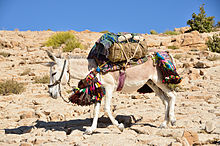Mode of Transport
Transport are working or production means that the transport of persons ( passenger transport ) or goods ( freight transport serve).
General
Means of transport are intended not only to transport the vehicle driver ( driver , flight captain , captain , train driver ), but also serve to transport goods ( freight ) and people ( passengers ). That is why not all modes of transport are also means of transport. Since, for example, the electric scooter may only transport the driver in accordance with Section 8 of the Small Electric Vehicle Ordinance , it is a means of transport and not a means of transport. Means of transport do not have to be vehicles , including pack animals (such asDonkeys or camels ) belong to the means of transport. Items that do not have their own drive , such as containers , bottles ( message in a bottle ), suitcases , pallets , postal parcels or bags are called transport aids .
External or inter- company transport ( traffic ) is carried out using means of transport. These include, in particular, vehicles such as motor vehicles ( buses , cars [including taxis ], trucks ), watercraft ( inland and seagoing vessels ), railways , airplanes or spacecraft . Internal transport ( intralogistics ), on the other hand, is also carried out with subsidies . These include conveyor belts , screw conveyors , forklifts , cranes and driverless transport vehicles . Both the external and internal transport of gases or liquids can be carried out with pipelines or in containers by means of conveying or means of transport.
Legal issues
The legal term means of transport appears frequently in laws, but there is no legal definition . Section 15 (2) of the ArbSchG stipulates that means of transport as work equipment may only be used as intended. The Federal Police must helicopter according to § 60 Federal Police Act to use as police use and transport as well as for the transport of members of the constitutional bodies of the Federation, members of the federal government and their guests. In § 6 para. 1 Single Market for Animal Health Protection Act (BmTierSSchV) prescribes that animals and goods may not be moved in vehicles or containers within the Community or imported, which the there for them in Appendix 2 column 2 BmTierSSchV meet stated requirements.
economic aspects
A transport risk arises from means of transport . Transporting people can result in personal injury or property damage . In addition to the risk of damage , theft , shrinkage , spoilage or loss of goods in sustainable supply chains, the transport of goods involves the risk that the means of transport used cause social or ecological damage such as emissions or noise pollution . Also delays by transport means (such as congestion ) are among the transportation risks.
In the case of means of transport, the degree of utilization can be precisely determined. A distinction must be made between seat occupancy in passenger transport and payload or loading ton kilometers in freight transport. They are important for transport companies because the fixed costs change from idle costs to utility costs when the utilization rate increases . Empty costs arise in the case of "empty trips" when capacities are not or not fully utilized. If the breakeven point is exceeded with increasing workload , profits are generated . The higher the break-even point in a company is, the higher the utilization risks, where the total cost only at a relatively high utilization rate covered are. When the breakeven point is exceeded, the fixed costs are distributed over a larger number of units (e.g. passengers), which reduces unit costs and increases profits ( fixed cost degression ). In order to achieve the company 's goal of maximizing profit , however, the aim should be to achieve a higher degree of utilization, at a maximum of 100%.
The degree of utilization can be influenced by various measures. If the breakeven point is lower, for example by reducing costs , the utilization risks of a transport company decrease and vice versa. For a given breakeven utilization can be improved by price reduction (higher demand ), price differentiation ( happy hour , day or night prices), vertical product differentiation ( quality competition ), extension of the operating times and shorter fallow periods , introduction of seasonal operation or by overbooking (also for Avoidance of no-shows ), which aims to fully utilize capacities. In public transport , the modal split in particular influences seat occupancy.
The average costs per passenger mile or freight mile (regardless of route length and flight volume) in scheduled services form the basis of assessment for flight prices in order to achieve a targeted return on capital taking into account expected occupancy . Seat occupancy tends to be lower in scheduled services than in charter services .
See also
literature
- Heinrich Martin: Transport und Verkehr , Vieweg Teubner, 7th edition, pp. 9, 96–98.
Individual evidence
- ↑ Stefan Eckert / Georg Trautnitz (eds.), International Management and the Basics of Globalized Capitalism , 2016, p. 473
- ↑ Springer Fachmedien Wiesbaden (ed.), Kompakt-Lexikon Management , 2013, p. 426
- ↑ Dieter Lohse / Werner Schnabel, Fundamentals of Road Traffic Technology and Traffic Planning , Volume 1, 2011, p. 558
- ↑ Gerd Aberle, Transportwirtschaft: Individual economic and macroeconomic foundations , 2003, p. 196
